First chapter of oral history films of Isfahan Bazar unveiled
Accompaniment of oral and visual history
Maryam Assadi Jafari
Translated by M. B. Khoshnevisan
2018-5-9
According to the website of Iranian Oral History, “the ceremony for unveiling the first chapter of the collection of oral history films of Isfahan Bazar” attended by a number of veterans of the bazar and organized by Assar Khaneh Shahi Museum (the Center for Studies of Isfahan’s Public Culture) was held in the Conference Hall of the Central Library of the city of Isfahan on Sunday 29th of April 2018.
In the beginning of the ceremony, Mohammad Memarian, the Head of Assar Khaneh Shahi Museum said, “Assar Khaneh Shahi Museum, as a center for studies of Isfahan’s public culture and traditional jobs started the oral history of Isfahan’s bazar since February 2017. 15 sections of the Qeisarieh Bazar and 10 persons from every section were selected for interview, and eventually, 147 interviews were conducted with these leaders of the bazar. The oral history project of Isfahan’s bazar launched a new chapter in the history of Isfahan, which we hope it continues with the cooperation of the people and authorities, and the untold events of the elders of the city of Isfahan will be written down.”
Then, Abolhassani Taraqi, the manager and executor of the oral history project of Isfahan’s Bazar introduced the society and bazar as the main university and said, “Everyone who likes to learn something should enter the society. If someone restricts himself or herself in the library and the documents center, he or she learns nothing.”
He reviewed the course of historiography in the west and Europe, and added, “The look at history has been changed for a long time. The historiographies which are carried out in central and northern Europe and the new world of America do not focus solely on political history, but also on socio-cultural history and the lives of people. This change in vision and method came to Iran from the western countries at the end of the Qajar period. Although it was not launched as a current in Iran, unfortunately until today, we still witness that paying attention to political history is one of the dominant methods.”
This oral history activist emphasized, “People have been seen less in our government documents and some traces of social history are seen in our literary verse and prose since the early post-Islam era until lately In continuation of this course, exactly 70 years ago, a method for collecting historical information in the West known as oral history was recorded. Today, oral history is recognized as a school of historiography or a way of looking at the history or collection of books with this title, but the main point is that oral history is a method and mechanism for collecting historical data and information on various topics of contemporary history and social history among the masses of the people and the descendants and not the ascendants of the society.”
Abolhassani continued, “Today, we have many documents about the great Kazeroonis, Hamedanis and Kashefis in Isfahan. Is there any document about the workers of factories except a few ones about the number of the workers? Isfahan has been a labor city and known as “Iran’s Manchester”. Why shouldn’t have we the best museum of textile industry today?”
The manager and executor of the oral history project of Isfahan’s Bazar emphasized on the significance of conducting methodological, targeted, open, questionable, challenging, two-way, active and completely scientific interviews in the area of oral history, and pointed out, “That we quote our history and literature chest to chest since thousands years ago has nothing to do with oral history. Memory-telling and memory-writing have nothing to do with oral history. Thus, an oral historian stands against a history narrator who may be a worker, an employed lady, a craftsman or an artist. The professors whom we interviewed are not only a producer but an artist. Their hands make a miracle. When we talk to them, part of the past and the history of bazar is clarified which unfortunately, the recession of the market comparing with the past also becomes clear.”
Dr. Mehdi Abolhassani regarded the collection and registration of political-social-cultural and religious history as another responsibility of oral history and said, “The largest and oldest charity institutions are in in Isfahan and registration of its oral history is of great importance. The mourning month of Moharam and religious gatherings in Isfahan are an arena for showing our culture which have also traces in the bazar. When we review the history of bazar, we also deal with religious gatherings and see the impact of the gatherings in the course of history too. We have live witnesses since the past 50 to 60 years which have played a major role in the historical developments of the city of Isfahan about whom have also been spoken.
He evaluated oral history far from any personal taste, and added, “Oral history of Isfahan’s Bazar is the first phase out of the three-phase plan of Isfahan’s oral history, and at least 500 interviews should be conducted so that they turn into books after passing through research filters. In the first phase and the oral history project of Isfahan’s bazar, we conducted 147 hours of interview for 13 months intensely because nobody knows of a moment later. Nearly 5 percent - that is, about 7 people - from the loved ones we interviewed, passed away, and the late Gholam Reza Kafsh Resan and the late Haj Hussain Spitali, one of the carpet market elders, were among them. We have to hurry because they are old and it is unclear what will happen.”
The author of the book “Oral History and its Status in Iran’s Contemporary Historiography” presented brief figures from the conducted interviews in oral history project of Isfahan’s bazar, and said, “We observed the whole bazar from Qeisarieh opening to the Great Bazar opening (Abd al-Razaq Street) and interviewed various guilds based on priority. The most figures – 24 interviews – belong to the guild of cloth from retailers, roll-sellers, bundle-sellers and market dealers and factories. 16 people including shoe-maker, producer, and seller of footwear, shoes seller and seller of different kinds of leathers have been interviewed. We interviewed 10 people in carpet industry which is unlikely that the information of any of these people have been included in any book. For instance, they talked about Armenian-Weaving design about which a few people have heard. The late Spitali spoke about master Ahmad Archang. He was a political activist some 70 years ago as well as an artist in every sense. They went to the prison and begged him to draw a carpet design for us. I enjoyed scientifically while working. In carpet industry, we have interviewed carpet mender, seller, merchant and the one who carries out carpet operation. We have also interviewed 11 enamellers namely the people who make trays, braziers, samovars, copper vases and pitchers, and nickel silvers and steels. There were also the leaders of samovar-making whose work advanced alongside with the Russian works and were the rivals of great and famous Russian samovar-makers. The dispersal of this job in Isfahan is very much. We also interviewed 9 Kalamkars (Kalamkari or qalamkari is a type of hand-painted or block-printed cotton textile) including master Faqfouri. The products of our long-standing industry are cheap, and I hope that one day this art is used on the clothes of our girls instead of foreign fabrics. Finally, we have interviewed 5 goldsmiths and 3 gold embroiderers. I also searched to find three old porters. A regular porterage organization had been existed in bazar in the past, but now one of the problems of the bazar is the mess in carrying loadings. We tried to look for special terms and concepts of each guild. These are our culture which is being forgotten.”
Abolhassani pointed out that the problems of every art and industry of Isfahan’s bazar have been reviewed during the oral history project, and added, “We have also focused on the old and new situation of the bazar. Previously, all producers were present in the shoes market but now they sell inferior foreign products. We extracted the past 100-year history from people like the 90-year old Haj Abbas Ali Fani. He has the ability to quote his father and grandfather. We even sought for the physical changes of the bazar and a series of legal issues on property. All of these questions were asked for scientific purposes.”
In conclusion, the head of oral history project of Isfahan's bazar pointed out, "This project should be completed to respond. The number of interviews should be increased to the ceiling which requires the completion of the second and third phases of the oral history project of Isfahan's bazar. The sample of our work is found nowhere in Iran except in Astan-e Qods Razavi which is active in the area of social history."
In continuation of the ceremony of unveiling the first chapter of the collection of oral history films of Isfahan's bazar, Hussain Dehbashi, the Manager of Iranian Oral Histoiry Project referred to some sentences from the book "The Lessons of History" by Will Durant, "When many historians look at the history, it seems as if they look at the narration of a river from the perspective of a stream in order to see that the stream has been filled with blood by the leaders and conquerors, it has become drought or turbulent and a few people look at the banks of the stream. Because concurrent with the events happened in the stream's bed by the commanders, there are people in the banks who make love, raise children and live." He continued, "We may add these sentences to Will Durant's writings that perchance, there are the same banks of the stream which determine the stream's direction most of the times. We mistakenly exaggerate about the role of kings and commanders. It is these people who provide the grounds for the overthrow of a ruler. What is happening in the area of the oral history of Isfahan's bazar is, in fact, the same attention to the bank."
Dehbashi continued, "When we talk about the city of Isfahan, it is of great importance for us to pay attention to every dimension of it in national dimensions. I wonder how such a project has been defined in the form of a project. Certainly, you need an oral history research center in Isfahan. I hope the city's elders will do their utmost to accomplish this important task."
He regarded the oral history project of Isfahan's bazar as unique in Iran and stipulated, "This project in terms of scientific methodology is among few oral history projects which is conducted by an oral history student. Although there are many claimants in the field of oral history in Iran and from any project with a trace in history recorded orally, there is a claim to put the name of oral history on it."
The Head of Iranian Oral History project emphasized, "Oral history has appealed to the market and researchers and has many claimants. But the number of those who have studied in the area of oral history in the entire Iran does not reach to 5 and we are glad that Dr. Abolhassani is one of the prominent figures of this area. Everything he does, is regarded as a model for other projects in Iran methodologically."
Referring to lack of attention to social history in Iran, Hussain Dehbashi said, "Most projects are in the area of politics and the predominant look has influenced the projects so much that as if a researcher is expected to reach certain findings, and from this viewpoint, the oral history projects are extremely vulnerable. This usually happens in the area of war and Islamic revolution, and thus, the oral history project of Isfahan's bazar is unique. This high volume of the work is also exceptional. However, I think that the requirements and limitations of the work have caused the oral history project in Isfahan to be damaged in some cases. This volume of work cannot be done by just one person. I am sure Dr. Abolhassani has agreed to do this with much pain and suffering, because sitting along with these respected people needs hours of conversation. Otherwise, it's really hard to record this volume of findings in a short amount of time."
Having criticized the oral history project of Isfahan's bazar, he said, "Today, an oral history researcher must also consider the areas of oral and visual history together. Now, oral history has been turned into oral and visual history. It seems that the project has first focused on only the area of audio and text and later, the image has been added to it. Body language and language twists are important points that are especially important in a particular area like Isfahan. I hope the supporters in the next steps add more time for working, and make sure to take a visual record. "
The Head of Iranian Oral History Project added, "The other point the lack of which is due to limitations is the supplementary documents and appendices. When a bazar elite is talked, his photo album, working tools, ID documents and youth photos must certainly be provided and attached. I do not think this was possible in terms of logistics."
He emphasized, "Do not imagine that if someone makes a point in the area of any industry, it's a particular one for that industry. Giving an intersection to the materials that a person has brought up from the field of history and has been the informed witness of historical events in his own time reaches us to findings that have certainly not been recorded and registered in official and state documents. Of course, in the usual domain of history, they mostly refer to written documents. But we are a country that leaves less documents of ourselves and basically produce less documentation. People write less memories, newspapers do not have much life, and have been subject to audits and censures during their period, and outside of these discussions, they are less likely to enter the area of social journalism. All of these, and government documents which are not kept and produced well, cause a large portion of what we need as a historical backbone does not exist, and this doubles the importance of oral history. "
Referring to extraction of materials about tourism from the heart of oral history of Isfahan's bazar, Hussain Dehbashi said, "From the interviews, one can find out with what phenomena we are facing in the area of tourism, and makes possible the pathology and feasibility of this area in the arena of ultra-guild and nationally."
At the end of the ceremony for unveiling the first chapter of the collection of oral history films of Isfahan Bazar, versions of this project were donated to the veterans of Isfahan's bazar and history professors.
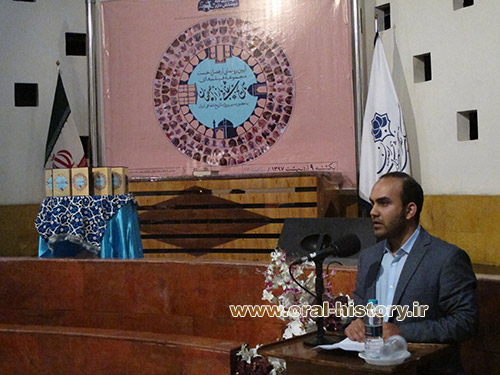
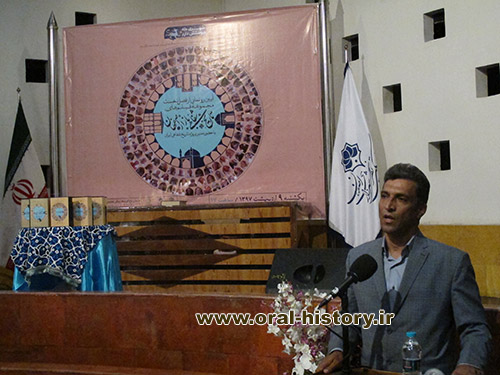
.jpg)
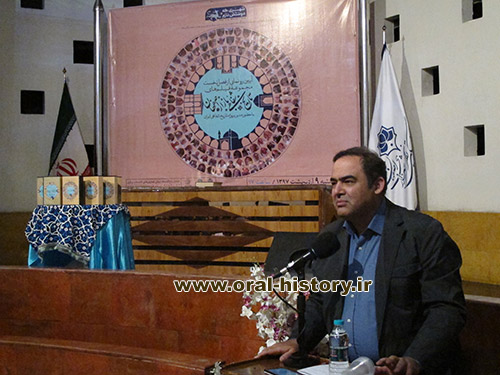
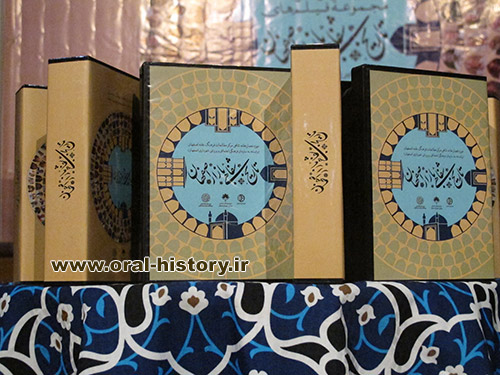
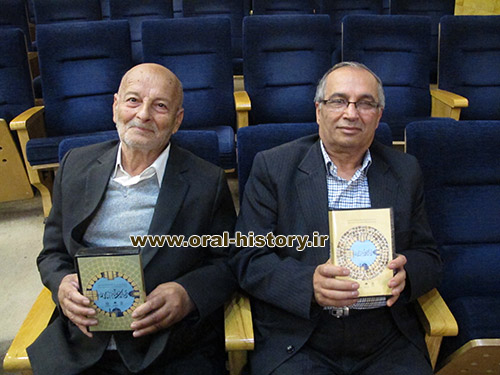
Number of Visits: 3688








The latest
Most visited
The Arab People Committee
Another event that happened in Khuzestan Province and I followed up was the Arab People Committee. One day, we were informed that the Arabs had set up a committee special for themselves. At that time, I had less information about the Arab People , but knew well that dividing the people into Arab and non-Arab was a harmful measure.Kak-e Khak
The book “Kak-e Khak” is the narration of Mohammad Reza Ahmadi (Haj Habib), a commander in Kurdistan fronts. It has been published by Sarv-e Sorkh Publications in 500 copies in spring of 1400 (2022) and in 574 pages. Fatemeh Ghanbari has edited the book and the interview was conducted with the cooperation of Hossein Zahmatkesh.Is oral history the words of people who have not been seen?
Some are of the view that oral history is useful because it is the words of people who have not been seen. It is meant by people who have not been seen, those who have not had any title or position. If we look at oral history from this point of view, it will be objected why the oral memories of famous people such as revolutionary leaders or war commanders are compiled.Daily Notes of a Mother
Memories of Ashraf-al Sadat SistaniThey bring Javad's body in front of the house. His mother comes forward and says to lay him down and recite Ziarat Warith. His uncle recites Ziarat and then tells take him to the mosque which is in the middle of the street and pray the funeral prayer (Ṣalāt al-Janāzah) so that those who do not know what the funeral prayer is to learn it.


